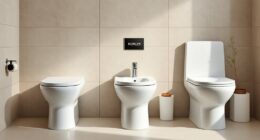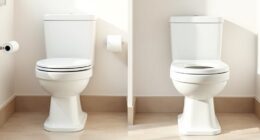When it comes to creating our ideal bathroom sanctuary, we all know that the right bathtub can make all the difference. So, how do we choose the perfect tub that brings bath-time bliss?
In this article, we’ll explore the various types of bathtubs, consider the size that fits just right, dive into the different materials available, and discuss the importance of design and functionality.
Get ready to soak in style as we guide you through the process of choosing the right bathtub for your bathroom.
Key Takeaways
- There are various types of bathtubs to choose from, including freestanding tubs, built-in tubs, clawfoot tubs, drop-in tubs, corner bathtubs, freestanding slipper tubs, and Japanese soaking tubs.
- Bathtubs can be made from different materials, such as acrylic and porcelain, each with their own pros and cons.
- When choosing a bathtub, consider factors like size and space, material and durability, and the functionality of jets and bubbles.
- Proper maintenance and care, like regular cleaning and addressing minor issues promptly, can help prolong the lifespan of the bathtub.
Types of Bathtubs: Exploring the Options
When it comes to types of bathtubs, we’re excited to explore all of the options available for our bathroom. One of the first decisions we need to make is whether we want a freestanding or built-in tub.
Freestanding tubs are a popular choice for those who want a luxurious and elegant look. They can be placed anywhere in the bathroom and often serve as a focal point.
On the other hand, built-in tubs are more practical and space-saving. They’re typically surrounded by walls and are easier to clean.
Another consideration is whether we prefer a clawfoot or drop-in tub. Clawfoot tubs have a classic and vintage appeal. They’re often made from cast iron and feature ornate detailing. These tubs are freestanding and sit on four claw-shaped feet, adding a touch of elegance to any bathroom.
Drop-in tubs, on the other hand, are designed to be fitted into a deck or platform. They’re versatile and can be customized with different materials and finishes.
Size Matters: Choosing the Perfect Fit
We found the perfect fit for our bathroom by considering the size of the bathtub. When it came to choosing a bathtub, we knew that finding a compact option would be essential for our smaller space. After careful research and consideration, we discovered some space-saving designs that would work perfectly for our bathroom.
Here are four options that we found:
-
Corner Bathtub: This design fits snugly into the corner of the bathroom, making efficient use of space. It allows for a comfortable bathing experience while maximizing floor space.
-
Freestanding Slipper Tub: With its raised back, this tub provides a luxurious soaking experience while still being compact. Its elegant design adds a touch of sophistication to any bathroom.
-
Drop-In Bathtub: This type of tub is installed by being dropped into a platform or surround. It offers flexibility in terms of size and shape, allowing for customization to fit any bathroom layout.
-
Japanese Soaking Tub: Inspired by traditional Japanese baths, these tubs are deep and have a small footprint. They’re perfect for creating a spa-like atmosphere in a compact bathroom.
Material Magic: Which Material Is Right for You
After considering the size of our bathroom, we now need to decide which material is right for our new bathtub. When it comes to material options, two popular choices are acrylic and porcelain.
Acrylic bathtubs have gained popularity due to their durability and versatility. They’re lightweight, making installation easier, and they come in a variety of shapes, sizes, and colors. Acrylic also retains heat well, providing a comfortable bathing experience. However, it’s important to note that acrylic bathtubs can be prone to scratches and discoloration over time.
On the other hand, porcelain bathtubs are known for their elegance and timeless appeal. Made from natural materials such as clay and minerals, porcelain bathtubs offer a classic and luxurious look. They’re also highly resistant to scratches and stains. However, porcelain bathtubs tend to be heavier and more expensive than acrylic ones.
Soaking in Style: Design Considerations
When it comes to designing your ideal soaking experience, there are a few key considerations to keep in mind.
First and foremost is the size and space available in your bathroom, as this will determine the type and dimensions of bathtub that will work best.
Additionally, the material and durability of the bathtub are important factors to consider, as they’ll impact both the aesthetics and lifespan of your chosen design.
Size and Space
For our bathroom, we opted for a smaller bathtub to maximize the limited space available. It was important for us to find a tub that would fit seamlessly into our small bathroom without sacrificing comfort or style. After careful consideration, we decided on a corner tub. Here’s why:
-
Space-saving design: The corner tub fits snugly into the corner of the room, making efficient use of the available space.
-
Optimal use of floor space: By placing the tub in the corner, we were able to free up valuable floor space for other bathroom fixtures and storage.
-
Enhanced visual appeal: The unique placement of the corner tub adds visual interest to the bathroom, creating a focal point that elevates the overall design.
-
Cozy and intimate setting: The corner tub provides a cozy and intimate bathing experience, perfect for unwinding after a long day.
Material and Durability
The material of our corner tub is durable and long-lasting, ensuring that it will withstand daily use for years to come. When choosing a bathtub, it is important to consider the material it is made of, as it directly impacts the longevity and maintenance required. To help you make an informed decision, we have created a table comparing three popular bathtub materials: acrylic, fiberglass, and cast iron.
| Material | Longevity | Maintenance |
|---|---|---|
| Acrylic | High | Low |
| Fiberglass | Medium | Medium |
| Cast Iron | Very High | High |
Acrylic tubs offer high longevity and low maintenance, making them a popular choice for many homeowners. Fiberglass tubs have a medium lifespan and require moderate maintenance. Cast iron tubs, on the other hand, have a very high longevity but require more maintenance to keep them in top condition.
Considering these factors will ensure that you choose a bathtub that not only meets your needs but also lasts for years to come. Now, let’s explore the functionality aspect of a bathtub, including jets, bubbles, and more.
Functionality Matters: Jets, Bubbles, and More
When it comes to choosing the perfect bathtub, functionality is a key consideration for us.
Jets and bubbles offer a luxurious experience, but we understand that personal preferences may vary.
That’s why we want to explore the importance of these features and how they can enhance your bathing experience.
Jet or Bubble Preference
We can’t decide whether we prefer jets or bubbles for our bathtub. Both options offer unique benefits and create a luxurious bathing experience. To help you make a decision, here are some key factors to consider:
-
Bath salts vs bath bombs: If you enjoy the therapeutic properties of bath salts, jets may be your best choice. They can circulate the water, ensuring the salts are evenly distributed. On the other hand, if you prefer the colorful and aromatic experience of bath bombs, bubbles can provide a more enjoyable and visually pleasing soak.
-
Relaxation vs hydrotherapy: If your main goal is relaxation and creating a tranquil atmosphere, bubbles are ideal. They create a gentle and soothing massage-like effect, helping to relieve stress and promote relaxation. However, if you’re looking for more targeted hydrotherapy benefits, such as muscle relaxation or improved blood circulation, jets are the way to go. They can provide a stronger and more invigorating massage experience.
Ultimately, the decision between jets and bubbles depends on your personal preferences and desired bathing experience. Consider the benefits of each and choose the option that best suits your needs.
Importance of Bathtub Features?
As homeowners, we prioritize the features of our bathtub to ensure a relaxing and luxurious bathing experience. The importance of bathtub features can’t be overstated, as they can greatly enhance our overall well-being.
One key feature that stands out is the option for hydrotherapy. Hydrotherapy involves the use of water to provide therapeutic benefits such as pain relief, stress reduction, and improved circulation. By incorporating jets or bubbles into our bathtub, we can enjoy the benefits of hydrotherapy right in the comfort of our own home.
The warm water combined with the massaging action of the jets or bubbles can help soothe tired muscles and joints, promote relaxation, and alleviate tension. This not only enhances our bathing experience but also contributes to our physical and mental well-being.
Installation Made Easy: What You Need to Know
Installing a bathtub is a breeze when you’ve the right tools and follow the proper instructions. Here are some installation tips to ensure a smooth process and avoid common mistakes:
-
Measure twice, install once: Before starting the installation, measure the space where the bathtub will be placed. Ensure that the dimensions of the tub match the available space to avoid any fitting issues later on.
-
Check for plumbing compatibility: Ensure that the existing plumbing in your bathroom is compatible with the bathtub you’re installing. It’s important to check the drain, water supply, and any other connections to ensure a proper fit.
-
Use the right materials: When installing the bathtub, make sure to use the appropriate materials such as screws, brackets, and sealant. Using the wrong materials can lead to leaks and instability.
-
Follow the instructions: Read and follow the manufacturer’s instructions carefully. Each bathtub may have specific installation requirements, and it’s important to follow them to ensure proper installation and avoid any damage.
By following these installation tips and avoiding common mistakes, you can ensure a successful bathtub installation in your bathroom.
Now, let’s move on to the next section about budget-friendly options: finding the right price.
Budget-Friendly Options: Finding the Right Price
When it comes to finding the right price for your bathtub, there are plenty of affordable alternatives to choose from. Exploring cost-effective bathtub options can help you save money while still achieving the perfect bathing experience.
One of the best ways to find budget-friendly bathtub deals is by bargain hunting. Start by researching different retailers and comparing prices. Look for sales, discounts, and promotions that can help you save some extra cash. Additionally, consider purchasing a bathtub during off-seasons when prices tend to be lower.
Another tip for finding budget-friendly bathtub deals is to consider alternative materials. While porcelain and acrylic tubs may be more expensive, there are other options such as fiberglass or cast iron that can be more affordable. These materials still offer durability and functionality without breaking the bank.
Once you’ve found the right price for your bathtub, it’s important to keep it in top shape. In the next section, we’ll discuss maintenance and care tips to ensure your bathtub lasts for years to come.
Transition: Now that we’ve explored budget-friendly options, let’s move on to the next section and discuss maintenance and care: keeping your bathtub in top shape.
Maintenance and Care: Keeping Your Bathtub in Top Shape
To ensure our bathtubs last for years to come, we need to prioritize regular maintenance and care. Here are some bathtub maintenance and cleaning tips to help keep your bathtub in top shape:
-
Regular Cleaning: Clean your bathtub at least once a week to prevent dirt and grime buildup. Use a mild, non-abrasive cleaner and a soft cloth or sponge to gently scrub the surface. Rinse thoroughly with warm water.
-
Avoid Harsh Chemicals: Harsh chemicals can damage the surface of your bathtub. Avoid using abrasive cleaners, bleach, or ammonia-based products. Instead, opt for natural cleaning solutions such as baking soda and vinegar.
-
Prevent Stains: To prevent stubborn stains, wipe down your bathtub after each use. This will remove any soap scum or residue. Additionally, consider using a bathtub mat or non-slip stickers to prevent scratches and stains caused by abrasive materials.
-
Address Minor Issues: Don’t ignore minor issues such as cracks or chips in your bathtub. Address them promptly to prevent further damage. For minor cracks, you can use a bathtub repair kit to fix the problem. If the damage is more severe, it’s best to consult a professional.
Frequently Asked Questions
Are There Any Safety Features to Consider When Choosing a Bathtub?
When choosing a bathtub, it’s important to consider safety features. Non-slip surfaces are crucial for preventing accidents and ensuring the well-being of everyone using the tub.
Additionally, accessibility is a key consideration, especially for individuals with mobility limitations. Ensuring that the bathtub is easily accessible and has features like grab bars can greatly enhance safety and convenience.
How Do I Determine if a Bathtub Will Fit Through My Bathroom Door?
When it comes to bathtub installation, one important consideration is whether the bathtub will fit through your bathroom door.
To determine this, you need to measure the width of your bathroom door. Start by taking accurate measurements of the door frame, including any trim or molding.
Then compare these measurements to the dimensions of the bathtub you’re considering. It’s crucial to ensure that the bathtub will fit through the door before proceeding with the installation process.
Can I Install a Bathtub Myself, or Do I Need to Hire a Professional?
Installing a bathtub can be a challenging task. It requires careful planning and attention to detail. However, with the right tools and knowledge, it’s possible to install a bathtub yourself.
Hiring a professional can ensure a seamless installation and may save you time and effort. The cost of bathtub installation can vary depending on factors such as the type of bathtub, the complexity of the installation, and any additional plumbing work required.
It’s recommended to get quotes from professionals to determine the best option for your needs.
What Are the Benefits of Having Jets or Bubbles in a Bathtub?
Having jets or bubbles in a bathtub offers numerous benefits. Firstly, they provide hydrotherapy, which can help relax muscles, reduce stress, and improve circulation.
Secondly, they create a spa-like experience, allowing you to enjoy a soothing massage while bathing.
When choosing the right bathtub size for your needs, consider the number of jets or bubbles you prefer and ensure there’s enough space for them.
This will ensure that you can fully enjoy the benefits of hydrotherapy in the comfort of your own bathroom.
How Do I Properly Clean and Maintain My Bathtub to Keep It in Good Condition?
Cleaning tips and tricks are essential for maintaining a bathtub in good condition. Regularly scrubbing the tub with a non-abrasive cleaner helps remove dirt and grime.
It’s important to pay attention to common bathtub problems like mildew and soap scum buildup, which can be tackled with a mixture of vinegar and water.
Additionally, keeping the drain clear of hair and debris and using a soft cloth or sponge for cleaning will keep your bathtub looking fresh and inviting.
Conclusion
In the search for the perfect bathtub, we’ve explored various types, sizes, materials, and designs. We’ve delved into the world of functionality and considered budget-friendly options.
Now, it’s time to wrap up our journey by focusing on maintenance and care. Imagine stepping into a pristine bathtub, its gleaming surface inviting you to soak away the stresses of the day. With proper care and attention, your bathtub can remain a sanctuary of relaxation for years to come.



